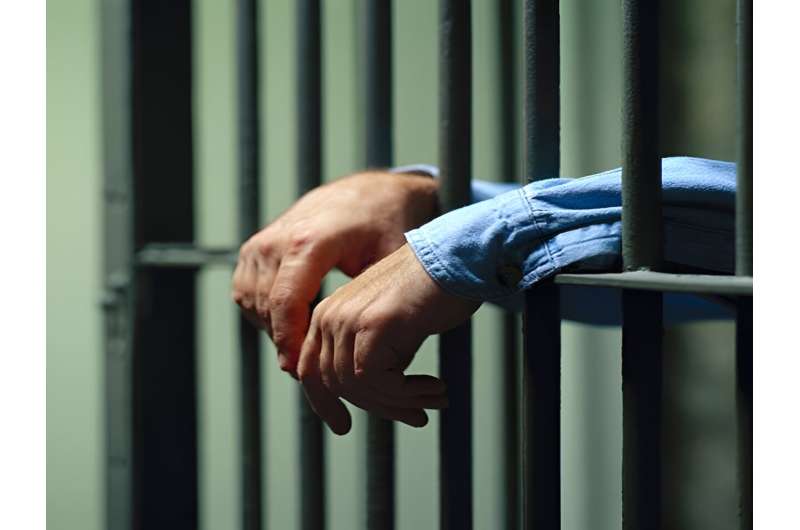This article has been reviewed according to Science X's editorial process and policies. Editors have highlighted the following attributes while ensuring the content's credibility:
fact-checked
peer-reviewed publication
reputable news agency
proofread
In America's prisons, suicide risk rises along with temperatures

Punishing heat is a fact of life inside America's prisons without air conditioning, and it is taking a serious toll on prisoners' mental health.
When the outside thermometer hits 90 degrees Fahrenheit or more, a new study shows that prison suicide risk jumps 36%, in comparison to when temperatures are in the 60s.
The finding comes from a look at the Louisiana prison system, one of the largest in the United States. It has been embroiled in legal action due to lack of air conditioning and extreme heat.
"Many of the spaces within prisons where incarcerated people eat, work and sleep do not have air conditioning," said study author David Cloud, who led the study as a doctoral student at Emory University Rollins School of Public Health in Atlanta. Cloud—who is now a fellow with the Amend program at the University of California, San Francisco School of Medicine—and his colleagues reported their findings Aug. 11 in JAMA Network Open.
The problem is particularly serious across the American South, Cloud said, pointing out that while extreme heat is dangerous for anyone in any environment, the prison population is particularly vulnerable.
"We are all feeling the effects of extreme heat, and I think most people recognize how spending too much time in the heat can affect their energy levels, mood and overall state of well-being," he said. "There is a reason that we have systems in place to warn people to take caution and adjust their daily routines when the heat becomes dangerous."
But, Cloud noted, there is literally no way out for prisoners.
"[They are] left alone in a poorly ventilated, concrete cell for most of the day, or confined in a crowded room with a hundred other people, and rendered powerless to find shade, plentiful cold water, a pool or lake to swim in, or refuge in an air-conditioned space," Cloud noted.
Such exposure to extreme heat is not just uncomfortable, he stressed. It can short-circuit the body's ability to cool itself down and maintain temperatures within a safe zone.
In extreme cases, the collapse of that process, called thermoregulation, can have deadly consequences. Short of that, the impact on mental health may be considerable, leaving a person feeling "more lethargic, aggravated and a little depressed," Cloud said.
That's a big concern among a population that already feels trapped and is dealing with trauma, depression and other mental health problems, he added.
Nationwide, there are about 2.1 million incarcerated men and women. The study notes that few jails and prisons are constructed to endure rising temperatures.
"[They] are mostly built with materials … that retain heat and have small or closed windows that impede air circulation, which creates conditions for indoor temperatures that exceed those outdoors," researchers point out in background notes. In addition, overcrowding can intensify the physical and mental strain of heat exposures.
To learn more about how extreme heat affects suicide risk in prison settings, Cloud's team looked at six facilities controlled by the Louisiana Department of Corrections and Rehabilitation.
Louisiana is one of the most densely populated prison systems in the country, researchers noted. The state averages 35 days a year when heat reaches dangerous levels and is projected to average nearly 115 danger days a year by 2050, according to the study.
Nearly 10,000 men were incarcerated in those six prisons from 2015 to 2017, and researchers focused on those who were imprisoned for at least three-quarters of that time.
Investigators first made a prison-by-prison listing of "suicide-watch incidents" during the study time frame. They then gathered maximum heat index information for the six zip codes in which the prisons are located.
Temperatures in the 60s were considered moderate, while any temperature in the 80s was termed a "cautionary" health risk. Readings between 90 and 103 F were deemed an "extreme heat caution" risk.
Prison staffers declare a suicide watch when they determine a prisoner has a potential risk. Suicide-watch and maximum heat data were then compared.
When the heat index hit the 80s, suicide risk shot up by 29%. Extreme heat—temps over 90—was linked to a 36% spike.
"These are not based on clinical assessments, per se," Cloud said. "But suicide watch incidents are a reliable indication of someone experiencing serious distress and in need of help."
He hopes that the findings will call attention to one way in which "the climate crisis and mass incarceration are colliding."
Cloud said the findings should serve as a call "for our society to take urgent action to address the humanitarian and public health crises in our nation's prison system."
Kristie Ebi, a professor at the University of Washington Center for Health and the Global Environment in Seattle, reviewed the findings.
She noted that the heat-suicide link highlighted by the study in the context of prison settings is consistent with prior research, even if it hasn't specifically focused on the experiences of incarcerated populations.
"There is a rich literature on the association between heat exposure and adverse mental health outcomes," Ebi said, adding that those studies strongly support the notion that "prolonged exposure to heat increases the risk of adverse mental health outcomes."
More information: David H. Cloud et al, Extreme Heat and Suicide Watch Incidents Among Incarcerated Men, JAMA Network Open (2023). DOI: 10.1001/jamanetworkopen.2023.28380
2023 HealthDay. All rights reserved.




















